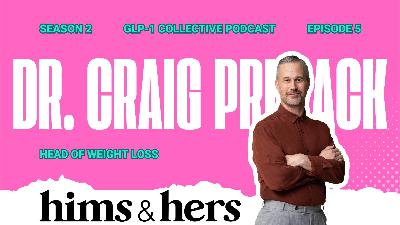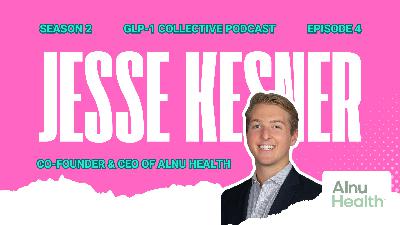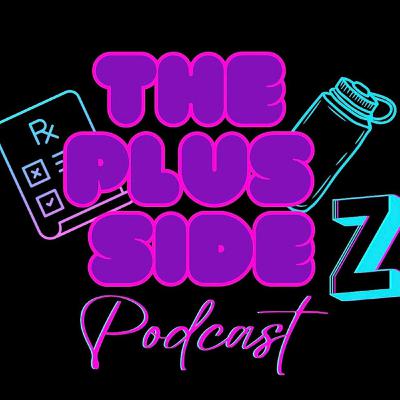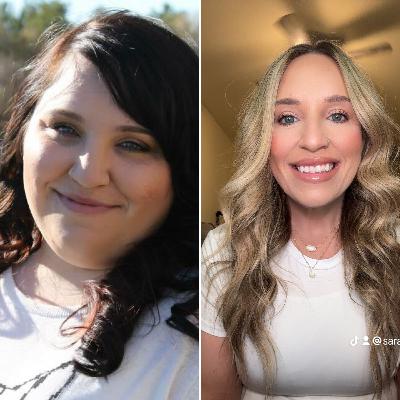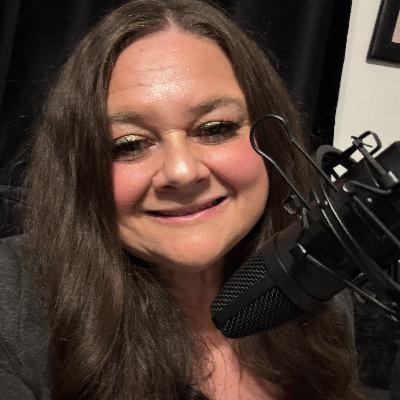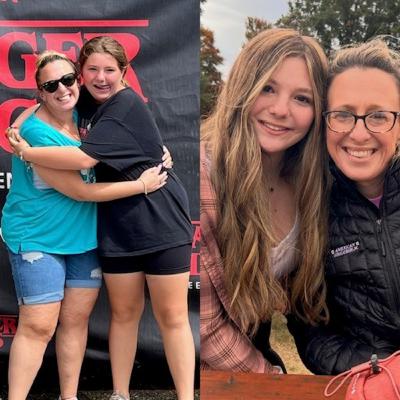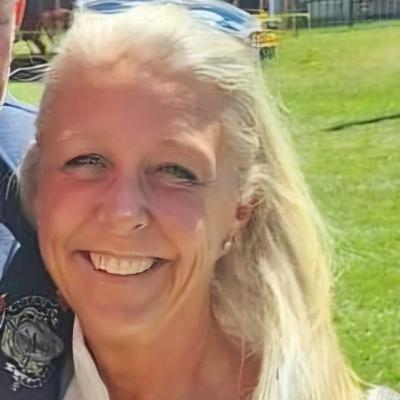Dr. Nina Crowley: Director of Clinical Education and Partnerships at SECA
Description
There are people in obesity care who make everything click: the science, the humanity, the why behind the numbers. Dr. Nina Crowley is one of those rare souls.
She’s a Registered Dietitian, Health Psychologist, and bona-fide Body Composition Expert who has spent two decades in the obesity-care trenches helping both patients and clinicians do better by people living in larger bodies.
She leads Clinical Education and Partnerships at SECA – Precision for Health, serves on the Board of Directors for the Obesity Action Coalition, and somehow still finds time to host her own podcast, In the Know with Nina.
She’s wicked smart, deeply compassionate, and the kind of educator who can explain complex research without ever talking down to you.
Think science in stilettos.
In The Know With Nina
I first met Nina through Dr. Lindsay Ogle (one of my favorite obesity specialists and a beloved Season One guest of the GLP-1 Studio Podcast.) Lindsay has this uncanny talent for connecting people who were clearly meant to collaborate, and Nina was no exception.
We hit it off immediately.
I had the privilege of being featured on her show, where we talked about advocacy, access, and freedom from food noise.
At that time Nina joined me to record the episode you’re reading about now, where she makes “bioimpedance vector analysis” sound like plain English… a magic trick, honestly.
We wrapped the interview, sent it off for editing, and I figured the story would pause there for a moment…
ObesityWeek
Fast-forward. I arrived at ObesityWeek representing the GLP-1 Studio Podcast and was heading back to my hotel when the universe decided to get playful. I didn’t just see one familiar face. I saw three.
Nina, Mike on a Mission, and Zach Niemiec.
Nina was instantly recognizable because she was in the middle of a handstand in front of the Olympic rings at Centennial Olympic Park.
It was a pose I’d seen often in her LinkedIn posts, and it was pretty easy to assume this woman knows how to have fun when you see her flipped upside down with a smile on her face at every serious conference.
We laughed, took a selfie, and promised to catch up later.
Unfortunately, later never happened because reasons, but there will absolutely be a next time.
And my story with Mike and Zach? Historical relevance that deserves a chapter of its own later.
And that tiny bit of serendipity ended up mattering more than I expected.
SECA Exhibit
Here’s where the universe pulled its little full-circle moment: the episode we recorded together, this episode, was already in queue.
I had just spent an hour listening to Nina re-explain, in detail, how the SECA system measures fat, muscle, and water using something called bioimpedance analysis.
Then I’m walking the exhibit floor with my GLP-1 girl gang and there it is. A full on SECA exhibit: 2 machines, and a giant screen that displayed the results.
Historically, sharing my stats would make me want to melt into the floor like a spilled latte, but let’s be real, we were all on GLP-1s and the whole point of this journey was to stop hiding and start self-advocating.
Besides, it felt like fate was tapping me on the shoulder saying:
The GLP-1 Girlies Get Scanned
Naturally, my friends wanted in, and it’s a good thing we jumped in when we did. It was practically a mosh pit by the time we finished.
One by one, they got scanned, all of them landing solidly in the healthy muscle range. Our resident fitness baddie, was nearly off the charts.
Then I stepped up to the plate and when my results flashed onto the big screen, my jaw dropped.
Now I didn’t just understand the data… I felt it.
When The Data Becomes Personal
This wasn’t your average bathroom scale. The vibrations running through my legs sent me, and seeing those charts was giving MRI without the MRI.
This was the exact science Nina had explained on the podcast, but now it was in living color with my name on it. I realized something important. I didn’t just understand it before. I only thought I did.
This time it actually landed.
The Numbers
BMI said average but “overweight,” but my skeletal-muscle index told a different story. It said healthy, strong, and absolutely capable. And for the first time in my life, getting weighed in public didn’t make me shrink. It made me curious.
The scan told me I had a healthy amount of muscle, but that I could stand to build about two more pounds. It wasn’t judgmental. It was factual.
Weight: 179.9 lbsBMI: 27.4Fat Mass: 71.4 lbs (about 40%)Fat-Free Mass: 108.5 lbs (about 60%)Skeletal Muscle: 50.6 lbsRecommended Goal: Gain 2 lbs of muscle
Was the number on the scale flattering? Absolutely not. But let’s be honest, I’m on a GLP-1 for a reason. These numbers weren’t an insult; they were a road map.
And that small note, gain two pounds of muscle, became a healthy, science-based, totally achievable goal.
Girl, Get Your Protein On
BioCare makes protein specifically for the GLP-1 girlies. It helps you hit your protein goals and stay satisfied without forcing down a heavy meal. And the strawberry flavor? My favorite. She’s serving “treat your self” energy with every sip.
Use code STUDIO for 20% off your order.
Why Body Composition Matters
This last year has been a masterclass in fear-based headlines: “Losing weight but gaining weakness? What Ozempic might be doing to your muscles.” And lets not forget, “Singer Avery Reveals Ozempic Left Her With Deadly Bone-Thinning Disease.”
Proof that GLP-1s must be the villain.
Never mind her age, medical history, nutrition, movement patterns, or the million other variables that affect bone health.
Here’s the part that keeps getting twisted: some GLP-1 studies report that in certain GLP-1 trials, reductions in lean mass accounted for 40–60% of the total weight lost. And that sounds terrifying, if you assume “lean mass” means pure skeletal muscle. But it doesn’t.
Nina explains:
“Lean mass isn’t the same thing as skeletal muscle. ‘Lean soft tissue’ is a DEXA term, and it includes water, organs, connective tissue — all of the fat-free parts of the body that aren’t muscle. So when you see changes in lean mass, that doesn’t automatically mean you lost muscle.”
Then she added the part most people never hear:
“Those early studies weren’t measuring muscle tissue directly. They were measuring lean soft tissue. Muscle is only one portion of that. So when people jump from ‘25–40% lean mass change’ to ‘you lost 40% of your muscle,’ that’s not what the data shows.”
The good news? Newer research is finally drawing that line clearly.
Papers like the 2025 review in Acta Diabetologica on muscle loss and GLP-1 agonists say it outright: changes in “lean mass” on a scan do not mean your muscles are vanishing.
Most of the weight lost is still fat, and in many cases muscle quality and function are stable or even improving as metabolic health gets better.
Once you see that distinction, the whole panic narrative starts to look less like biology and more like the research-equivalent of someone reading half a sentence and fainting on a velvet chaise.
The Patient Prospective
A lot of us carry this quiet, almost shame-soaked fear that we’re losing muscle, as if the world needed one more thing to blame us for.
For years it was weight. Now it’s muscle loss, a brand-new moral failing to shame us for.
So when we saw that we all checked out healthy, there was this soft, almost sacred collective sigh of relief.
The old stigma that you’ll wither away just didn’t hold up.
Can someone lose too much muscle on a GLP-1? Absolutely. The same way it can happen during crash diets, extreme calorie deficits, illness, or weeks stuck in bed.
That’s physiology, not a character flaw.
But the idea that these medications melt your muscle like whipped cream on a hot latte?
No, babe. Just no.
And now, instead of relying on guesswork or a $20 scale that shoots an electrical whisper up one leg and prays for statistical magic, we can actually see what’s happenin




